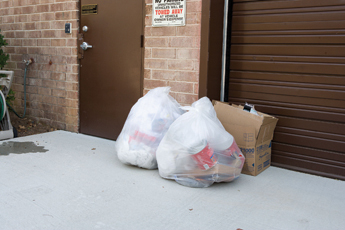
Keep Pests Out of the Kitchen
By Ron Harrison
Features Business and Operations Health & SafetyThe need to revitalize sanitation efforts in the kitchen
Pests and pizza don’t mix. Not only can the sight of
pests in your pizzeria turn off customers, but flies, rodents and
cockroaches can transmit bacteria such as E. coli and Salmonella that
can cause foodborne illness.
 Pests and pizza don’t mix. Not only can the sight of pests in your pizzeria turn off customers, but flies, rodents and cockroaches can transmit bacteria such as E. coli and Salmonella that can cause foodborne illness. A regular sanitation program can help protect your business from pests and keep your pizzeria clean at the same time.
Pests and pizza don’t mix. Not only can the sight of pests in your pizzeria turn off customers, but flies, rodents and cockroaches can transmit bacteria such as E. coli and Salmonella that can cause foodborne illness. A regular sanitation program can help protect your business from pests and keep your pizzeria clean at the same time.
During the summer pests enter your restaurant looking for food, water, shelter and protection from the heat. Sanita-tion plays an integral role in pest management because it helps reduce the attractiveness of these elements. When incorporated as part of an ongoing Integrated Pest Manage-ment (IPM) program, sanitation efforts that target pests help reduce the need for chemical treatments.
For the most effective sanitation program, focus your efforts in pest “hot spots,” or areas most likely to be inhabited by pests. The kitchen, and storage and waste areas, are all prime hot spots where pests can find moisture, food or hiding areas if your sanitation efforts don’t eliminate them. Work with your pest management professional to incorporate the following tips into your sanitation schedule:
Thoroughly sweep and mop the entire floor daily to remove food and liquid spills. Vigilance and thoroughness are important – studies indicate that one raisin can feed more than 300 cockroaches for a day and cockroaches can live for up to two months without a meal.
If your pizzeria stays open late at night, don’t wait until the next morning to clean. Pests are generally more active at night because during the day human activity and bright lights deter them.
Use a HEPA (High Efficiency Particulate Air) filter vacuum to clean debris that can linger in cracks and crevices. Cockroaches will eat just about anything, including dust, so it’s important not to leave anything behind when cleaning.
Remove the drain cap and scrub kitchen floor drains regularly with an organic cleaner to prevent small flies from breeding in the drain buildup.
Keep an eye out for leaky appliances, such as soda and ice machines, dishwashers, and sinks, which can provide pests moisture. Work with a maintenance professional to make repairs as needed.
Co-ordinate a comprehensive kitchen cleaning at least once each year to remove grease buildup from hard-to-reach areas, including the space behind and under all appliances.
Store food on open-backed wire shelving away from the wall and up off the floor. Keep food tightly sealed and rotate products on a first in, first out (FIFO) system to minimize the possibility of infestation. Monitor for and immediately dispose of damaged or infested product.
Line and seal all trash cans. Remove trash regularly, and don’t allow it to pile up outside the building; outside waste can encourage pests to come inside looking for more. Work with your waste management company to clean and rotate dumpsters and keep them as far from the building as possible.
The key to a successful sanitation program is teamwork. Involve your employees in your sanitation efforts and educate them on their role in the process. A sparkling clean pizzeria will signal pests to find another home this summer.•
Ron Harrison, Entomologist, PhD, is the Director of Training at the Orkin Training Center in Atlanta, Ga., and an acknowledged leader in the field of pest management. Contact Dr. Harrison at rharrison@rollins.com or visit www.orkincanada.ca for more information.
Print this page